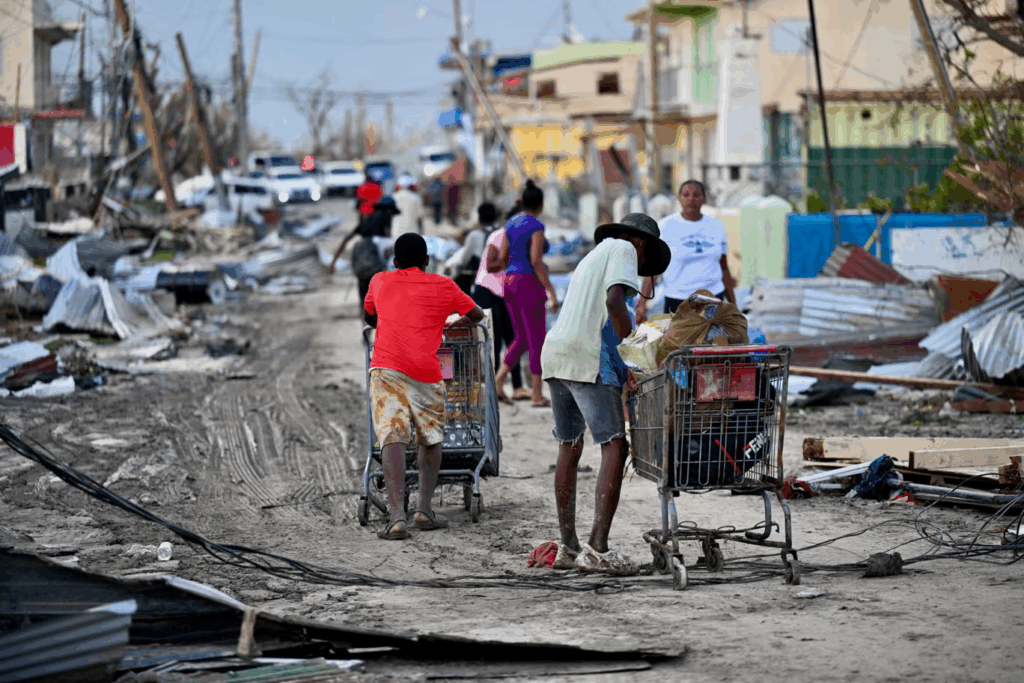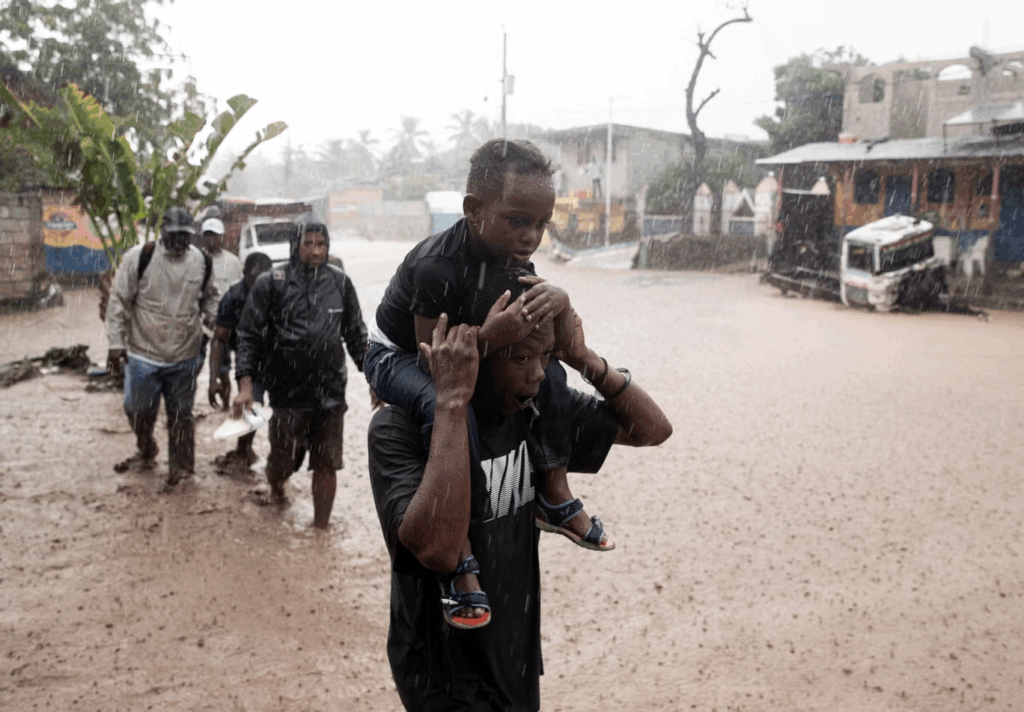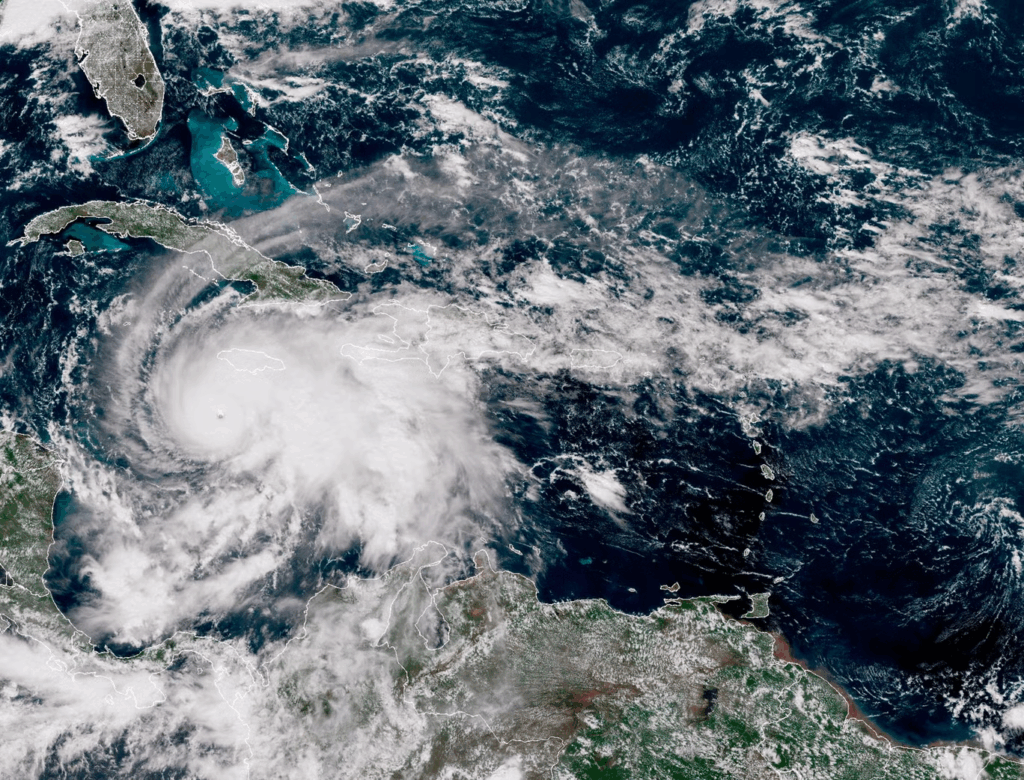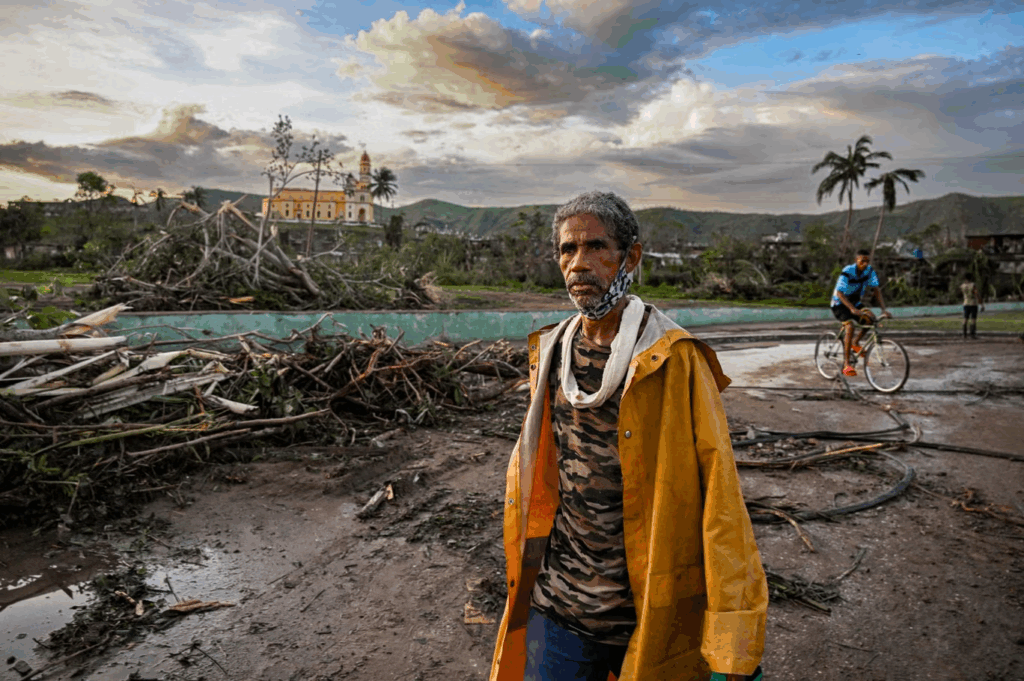The main purpose of this ongoing blog will be to track planetary extreme, or record temperatures related to climate change. Any reports I see of ETs will be listed below the main topic of the day. I’ll refer to extreme or record temperatures as ETs (not extraterrestrials).😜
Dear Diary. Because of Hurricane Melissa’s top sustained winds getting up to 185 mph, there are more calls for starting a Category 6 for hurricanes attaining winds above 190 mph. Let’s review categorical definitions used by the National Hurricane Center:
| Category | Sustained Winds | Types of Damage Due to Hurricane Winds |
|---|---|---|
| 1 | 74-95 mph 64-82 kt 119-153 km/h | Very dangerous winds will produce some damage: Well-constructed frame homes could have damage to roof, shingles, vinyl siding and gutters. Large branches of trees will snap and shallowly rooted trees may be toppled. Extensive damage to power lines and poles likely will result in power outages that could last a few to several days. |
| 2 | 96-110 mph 83-95 kt 154-177 km/h | Extremely dangerous winds will cause extensive damage: Well-constructed frame homes could sustain major roof and siding damage. Many shallowly rooted trees will be snapped or uprooted and block numerous roads. Near-total power loss is expected with outages that could last from several days to weeks. |
| 3 (major) | 111-129 mph 96-112 kt 178-208 km/h | Devastating damage will occur: Well-built framed homes may incur major damage or removal of roof decking and gable ends. Many trees will be snapped or uprooted, blocking numerous roads. Electricity and water will be unavailable for several days to weeks after the storm passes. |
| 4 (major) | 130-156 mph 113-136 kt 209-251 km/h | Catastrophic damage will occur: Well-built framed homes can sustain severe damage with loss of most of the roof structure and/or some exterior walls. Most trees will be snapped or uprooted and power poles downed. Fallen trees and power poles will isolate residential areas. Power outages will last weeks to possibly months. Most of the area will be uninhabitable for weeks or months. |
| 5 (major) | 157 mph or higher 137 kt or higher 252 km/h or higher | Catastrophic damage will occur: A high percentage of framed homes will be destroyed, with total roof failure and wall collapse. Fallen trees and power poles will isolate residential areas. Power outages will last for weeks to possibly months. Most of the area will be uninhabitable for weeks or months. |
Notice that at the high end of the scale the threshold for category 4 hurricanes is 130 mph. Once we see a system reach 157 mph it becomes a monster category 5. What if a hurricane reaches 185 mph or higher? At 185 mph using 2nd grade math we would have a system that is 28 mph stronger than threshold category 5 strength and about the same difference between the threshold for category 4 and 5. Would it not make sense to have a new top end category to account for systems getting roughly 25 mph stronger than the threshold for category 5?
I was calling for Category 6 as early as 2018 because of Irma:
For more pictures that I did not repost, hit the following link:
Extreme Temperature Diary- June 3, 2018/ Hot Topic: Calling for Category 6 – Guy On Climate
Before and since then other climate scientists have called for establishing a Category 6. Here is more grin the Independent:
Category 6 is the new hurricane normal, say scientists | The Independent
Category 6 is the new hurricane normal. Why scientists say we need to rethink what we know about storms
Human-caused climate change is making major hurricanes like Melissa much stronger, faster and ultimately more life-threatening
Julia Musto in New York
Friday 31 October 2025
Thought Category 5 was as bad as a hurricane could get? Think again.
As Hurricane Melissa barrels off into the Atlantic after devastating Jamaica and Cuba, some scientists say the age of Category 6 hurricanes is now upon us.
Storms fueled by human-caused climate change are stronger, intensify more rapidly and move faster than ever before, bringing destructive winds that rip off roofs and flooding coastal communities with feet of fast-moving ocean water that can linger for days after the immediate danger has passed, experts say.
Hurricanes are already exceeding the highest level of the wind-driven Saffir-Simpson Hurricane Wind Scale, which measures the amount of damage expected, capping off at “catastrophic” maximum sustained wind speeds of 157 miles per hour. Five tropical cyclones that formed since 2013 would have been deemed Category 6 hurricanes if such a classification existed.
Now, experts believe the 5 scale may no longer meet the moment and this week’s Hurricane Melissa is reinforcing that belief.

People search for food on the streets of Jamaica’s Black River community Wednesday following the passage of Hurricane Melissa. Scientists say climate-fueled storms like Melissa may necessitate the need for an increased hurricane scale AFP via Getty Images
The Category 5 storm – Jamaica’s worst on record – came close to a Category 6 hurricane, climatologist Dr. Michael Mann, Presidential Distinguished Professor in the Department of Earth and Environmental Science at the University of Pennsylvania, told The Independent.
It’s been proposed that such a hurricane would have maximum sustained winds of 192 miles per hour and could do much more damage than structures designed to withstand Category 5 winds are able to handle.
“I wouldn’t rule out that in post-season analysis, the wind estimates are upgraded, possibly breaching the ‘Cat. 6’ cut-off),” he said in an email, agreeing that these supercharged storms are the new normal and that we need to rethink how they are classified going forward.
“As long as we’re using wind-based metrics, it simply doesn’t make sense (mathematically, or fiscally and sociologically) to artificially cap the scale at 5 any more,” he said.
Adding Category 6 to the 2010-dated Saffir-Simpson scale would recognize the increasingly worrisome effects of climate change on hurricanes, including the greater risk of damage posed by worse storms, Dr. Katharine Hayhoe, Chief Scientist of The Nature Conservancy, told The Independent.

People walk through a flooded street Thursday in Petit-Goave, Haiti, following the passage of Hurricane Melissa. Much of the damage posed by hurricanes is related to precipitation, with warmer atmospheres able to hold more moisture (AFP via Getty Images)
She believes that there may also need to be a “full redo” of the scale to take precipitation into account, which is responsible for the majority of hurricane-related economic impacts.
“The argument over whether or not to add a Category 6 to the Saffir-Simpson scale actually ignores the forest for the trees because we’re now seeing that flooding damage is arguably just as if not a greater issue,” said Hayhoe.
However, not all scientists agree there’s a need to add to the scale — or even feel that strongly about it.
“I don’t think we need a Category 6. Uninhabitable for weeks or months is about as bad as it gets with hurricanes!” Colorado State University meteorologist Dr. Phil Klotzbach told The Independent in an email.
“The Saffir-Simpson scale has been around for decades,” Dr. Zachary Handlos, director of the Atmospheric and Oceanic Sciences Undergraduate Degree Program at Georgia Tech University, told WCNC. “If we change it, it becomes difficult to compare new storms to old ones unless we reanalyze past data. We’d be moving the goalposts for what defines a ‘major’ hurricane.”
“I don’t firmly feel either way,” meteorologist Jeff Berardelli wrote in a post on X. “But I do think if we continue to see these ‘league of their own storms then we need a way to separate ‘the men from the boys,’ if you will.”
What that may look like remains uncertain, but the reality is that climate change is making furiously strengthening storms like Melissa more likely, with major threats to humanity.

Hurricane Melissa churns over the Caribbean Sea. Melissa was one of the fastest intensifying storms of all time (Getty Images)
Melissa was one of the fastest intensifying storms of all time and tied for the most powerful storm for wind speed and pressure in the North Atlantic.
A recent study from Imperial College London found that Melissa was made four times more likely by human-induced climate change, boosting its wind speed by 11 miles per hour.
Warming ocean temperatures are part of what’s making hurricane winds stronger, Daniel Gilford, a meteorologist and atmospheric scientist with Climate Central, told The Independent.
“In the case of Melissa, we found that the extra ocean warming … increased Melissa’s intensity by something by 10 miles per hour which pushed it up to 185 miles per hour [maximum sustained winds],” he explained.

A resident of the town of El Cobre, Cuba, walks past downed trees, power lines and destroyed houses following the passage of Hurricane Melissa on Wednesday. The storm was made four times more likely due to climate change (AFP via Getty Images)
“So, we are sort of in this regime where these storms are kind of what we would think about as at the very top of our scale when it comes to intensity for the Saffir-Simpson scale.”
And, unless atmosphere-warming greenhouse gas emissions produced largely by the fossil fuel industry are curbed, these threats will continue to get worse.
“We are stuck with the world that we have now. We are stuck with the climate warming that we’ve experienced – about 1.3 degrees Celsius since pre-industrial [levels]. We are going to live during with our lifetimes with that temperature,” said Gilford. “So, these hurricanes are going to be more intense during our lifetimes.”
Here are more “ET’s” recorded from around the planet the last couple of days, their consequences, and some extreme temperature outlooks, as well as any extreme precipitation reports:
Here is More Climate News from Monday:
(As usual, this will be a fluid post in which more information gets added during the day as it crosses my radar, crediting all who have put it on-line. Items will be archived on this site for posterity. In most instances click on the pictures of each tweet to see each article. The most noteworthy items will be listed first.)